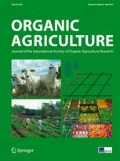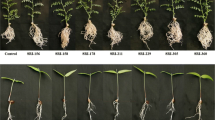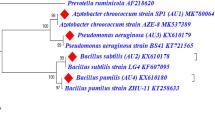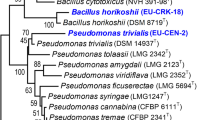Abstract
A study was carried out to test the effect of direct and indirect plant growth-promoting traits of bacteria, isolated from compost and rhizosphere soils, on chickpea. A total of 74 bacteria were isolated from herbal vermicomposts and rhizosphere soils of chickpea and screened for their antagonistic potential against soil-borne fungal pathogens of chickpea. Of which, four bacterial isolates (VBI-4, VBI-19, VBI-23, and SBI-23) were found to be promising in both dual culture and metabolite production assays. These isolates were identified as Bacillus species by 16S ribosomal DNA (rDNA) sequence analysis. Under in vitro conditions, all the isolates were found to produce protease, cellulase, β-1,3-glucanase, siderophore, indole acetic acid, lipase (except VBI-19), and hydrocyanic acid (except VBI-23 and SBI-23). All the isolates were tolerant to fungicides such as bavistin, captan, benlate, ridomil (only VBI-23 and SBI-23), and thiram (only VBI-4 and VBI-19) at field application rates. The isolates were also found to tolerate NaCl concentration of up to 8 % (VBI-23 up to 10 %), temperature range of 20 to 40 °C, and a pH range of 7 to 11 (SBI-23 up to only 9). When the isolates were evaluated for their plant growth promotion (PGP) ability under greenhouse and field conditions on chickpea, all the isolates were able to increase growth parameters including nodule number, plant growth, and yield parameters when compared to uninoculated control. The isolates also increased the soil mineral properties including total N, available P, organic carbon (OC) %, microbial biomass C, and dehydrogenase activity in rhizosphere, at both flowering and harvest stages over the uninoculated control plots. All the isolates were found to colonize chickpea roots when observed under scanning electron microscope. This investigation indicated the PGP potential of selected bacteria in chickpea cultivation.




Similar content being viewed by others
References
Akhtar MS, Siddiqui (2010) Effect of AM fungi on plant growth and root rot diseases of chickpea. Am-Eurasian J Agric Environ Sci 8:544–549
Altschul SF, Gish W, Miller W, Myers EW, Lipman DJ (1990) Basic local alignment search tool. J Mol Biol 215:403–410
Anderson TH, Domsch KH (1989) Ratios of microbial biomass carbon to total organic carbon in arable soils. Soil Biol Biochem 21:471–479
Bais HP, Weir TL, Perry LG, Gilroy S, Vivanco JM (2006) The role of root exudates in rhizosphere interactions with plants and other organisms. Ann Rev Plant Biol 57:233–266
Bhattacharya A, Chandra S, Barik S (2009) Lipase and protease producing microbes from the environment of sugar beet field. Ind J Agric Biochem 22:26–30
Boulter JI, Trevors JT, Boland GJ (2002) Microbial studies of compost: bacterial identification, and their potential for turfgrass pathogen suppression. World J Micro Biotechnol 18:661–671
Bozzola JJ, Russell LD (1999) In: Electron microscopy, principals and techniques for biologists. 2nd edn, Jones and Barlett publishers, Sudbury, pp 19–24, 54–55, 63–67
Bulluck LR, Brosius M, Evanylo GK, Ristaino JB (2002) Organic and synthetic fertility amendments influence soil microbial, physical and chemical properties on organic and conventional farms. Appl Soil Ecol 19:147–160
Casida LE (1977) Microbial metabolic activity in soil as measured by dehydrogenase determinations. Appl Environ Microbiol 34:630–636
Clarke H, Siddique K (2004) Response of chickpea genotypes to low temperature stress during reproductive development. Field Crop Res 90:323–334
Ellis RJ, Timms-Wilson TM, Bailey MJ (2000) Identification of conserved traits in fluorescent pseudomonads with antifungal activity. Environ Microbiol 2:274–284
El-Tarabily KA, Nassar AH, Hardy GESJ, Sivasithamparam K (2009) Plant growth-promotion and biological control of Pythium aphanidermatum, a pathogen of cucumber, by endophytic actinomycetes. J Appl Microbiol 106:13–26
Esitken A, Yildiz HE, Ercisli S, Donmez FM, Turan M, Gunes A (2010) Effects of plant growth-promoting bacteria (PGPB) on yield, growth and nutrient contents of organically grown strawberry. Sci Hortic 122:62–64
FAOSTAT (2014) Food and Agriculture Organization Statistical databases. Food and Agriculture Organization, Rome
Gopalakrishnan S, Suresh P, Mamta S, Humayun P, Keerthi KB, Sandeep D, Vidya MS, Deepthi K, Rupela O (2011) Evaluation of actinomycete isolates obtained from herbal vermicompost for the biological control of Fusarium wilt of chickpea. Crop Prot 30:1070–1078
Gopalakrishnan S, Upadhyaya HD, Humayun P, Srinivas V, Vidya MS, Alekhya G, Singh A, Vijayabharathi R, Bhimineni RK, Seema M, Rathore A, Rupela O (2012) Plant growth-promoting traits of biocontrol potential bacteria isolated from rice rhizosphere. Springer Plus 1:71
Gopalakrishnan S, Vadlamudi S, Bandikinda P, Sathya A, Vijayabharathi R, Rupela O, Kudapa B, Katta K, Varshney RK (2014) Evaluation of Streptomyces strains isolated from herbal vermicompost for their plant growth-promotion traits in rice. Microbiol Res 169:40–48
Gopalakrishnan S, Srinivas V, Alekhya G, Prakash B (2015) Effect of plant growth-promoting Streptomyces sp. on growth promotion and grain yield of chickpea (Cicer arietinum L.). 3 Biotech. doi:10.1007/s13205-015-0283-8
Gray EJ, Smith DL (2005) Intracellular and extracellular PGPR: commonalities and distinctions in the plant-bacterium signaling processes. Soil Biol Biochem 37:395–412
Habe MH, Uesughi CH (2000) An in vitro method for evaluating the ability of bacteria colonizing on tomato roots. Braz Phytopathol 25:657–660
Hendricks CW, Doyle JD, Hugley B (1995) A new solid medium for enumerating cellulose-utilizing bacteria in soil. Appl Environ Microbiol 61:2016–2019
Jannouraa R, Bruns C, Joergensena RG (2013) Organic fertilizer effects on pea yield, nutrient uptake, microbial root colonization and soil microbial biomass indices in organic farming systems. Eur J Agron 49:32–41
Keel C, Voisard C, Berling CH, Kahr G, Defago G (1989) Iron sufficiency, a prerequisite for the suppression of tobacco black root Rot by Pseudomonas fluorescens strain CHA0 under gnotobiotic conditions. Phytopathology 79(5):584–589
Khamna S, Yokota A, Lumyoung S (2009) Actinomycetes isolated from medicinal plant rhizosphere soils: diversity and screening of antifungal compounds indole-3-acetic acid and siderophore production. World J Microbiol Biotechnol 25:649–655
Lorck H (1948) Production of hydrocyanic acid by bacteria. Plant Physiol 1:142–146
Lugtenberg B, Kamilova F (2009) Plant-growth-promoting rhizobacteria. Ann Rev Microbiol 63:541–556
Mandal A, Patra AK, Singh D, Swarup A, Masto RE (2007) Effect of long-term application of manure and fertilizer on biological and biochemical activities in soil during crop development stages. Bioresour Technol 98:3585–3592
Nelson DW, Sommers LE (1982) Total organic carbon and organic matter. In: Page AL, Miller RH, Keeney DR (eds) Methods of soil analysis, Part 3, Chemical and microbiological properties. Soil Science of America, Inc, Madison, pp 539–579
Novozamsky I, Houba VJG, van Eck R, van Vark W (1983) A novel digestion technique for multiple element analysis. Commun Soil Sci Plant Anal 14:239–248
Olsen SR, Sommers LE (1982) Phosphorus. In: Page AL (ed) Methods of soil analysis, Part 2, Chemical and microbial properties, 2nd ed, Agronomy Monograph No 9. American Society of Agronomy, Madison, pp 403–430
Patten C, Glick BR (2002) Role of Pseudomonas putida in indole acetic acid in development of host plant root system. Appl Environ Microbiol 68:3795–3801
Rao GVR, Ratna Kumari B, Sahrawat KL, Wani SP (2015) Integrated Pest Management (IPM) for reducing pesticide residues in crops and natural resources. In: Chakravarthy AK (ed) New Horizons in insect science: towards sustainable pest management, pp 397–412
Saitou N, Nei M (1987) The neighbor-joining method: a new method for reconstructing phylogenetic trees. Mol Biol Evol 4:406–425
Schwyn B, Neilands JB (1987) Universal chemical assay for the detection and determination of siderophore. Anal Biochem 160:47–56
Shahzad SM, Khalid A, Arshad M, Khalid M, Mehboob I (2008) Integrated use of plant growth promoting bacteria and P-enriched compost for improving growth, yield and nodulation of chickpea. Pak J Bot 40:1735–1741
Siddiqui ZA (2006) PGPR: prospective biocontrol agents of plant pathogens. In: Siddiqui ZA (ed) PGPR: biocontrol and biofertilization. Springer, The Netherlands, pp 111–142
Singh PP, Shin YC, Park CS, Chung YR (1999) Biological control of Fusarium wilt of cucumber by chitinolytic bacteria. Phytopathology 89:92–99
Sreevidya M, Gopalakrishnan S, Melø TM, Simic N, Bruheim P, Sharma M, Srinivas V, Alekhya G (2015) Biological control of Botrytis cinerea and plant growth-promotion potential by Penicillium citrinum in chickpea (Cicer arietinum L.). Biocontrol Sci Tech 25:739–755
Suarez-Estrella F, Vargas-Garcıa C, Lopeza MJ, Capelb C, Morenoa J (2007) Antagonistic activity of bacteria and fungi from horticultural compost against Fusarium oxysporum f. sp. melonis. Crop Prot 26:46–53
Thompson JD, Gibsom TJ, Plewniak F, Jeanmougin F, Higgins DG (1997) The clustal X windows interface: flexible strategies for multiple sequence alignment aided by quality analysis tools. Nucleic Acids Res 24:4876–4882
Walker TS, Bais HP, Grotewold E, Vivanco JM (2003) Root exudation and rhizosphere biology. Plant Physiol 132:44–51
Acknowledgments
MS would like to thank Council of Scientific and Industrial Research, New Delhi, India, for the financial support for research during her PhD. This work was undertaken as part of the CGIAR Research Program on Grain Legumes. ICRISAT is a member of CGIAR Consortium. We also extend our thanks to Mamta Sharma, Legumes Pathology, ICRISAT, for providing the fungal pathogens of chickpea and all the staff members of biocontrol unit, including G Alekhya, V Srinivas, PVS Prasad, P Manohar, B Nagappa, D Bharath, and A Jabbar, for their inputs in the laboratory and field experiments.
Author information
Authors and Affiliations
Corresponding authors
Ethics declarations
Conflict of interest
Authors declare that they have no financial/commercial conflicts of interest.
Rights and permissions
About this article
Cite this article
Sreevidya, M., Gopalakrishnan, S. Direct and indirect plant growth-promoting abilities of Bacillus species on chickpea, isolated from compost and rhizosphere soils. Org. Agr. 7, 31–40 (2017). https://doi.org/10.1007/s13165-015-0141-3
Received:
Accepted:
Published:
Issue Date:
DOI: https://doi.org/10.1007/s13165-015-0141-3




